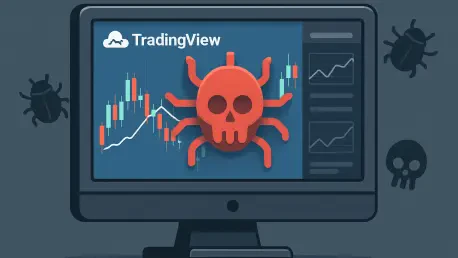In the ever-evolving landscape of cybersecurity threats, staying informed about the latest scams and malware campaigns is crucial for digital safety. Today, we’re speaking with Oscar Vail, a renowned technology expert with deep insights into emerging fields like quantum computing, robotics, and open-source projects. With his finger on the pulse of the tech industry, Oscar is here to break down a recent malicious campaign involving a fake TradingView app and the advanced Brokewell malware, shedding light on how cybercriminals are targeting Android users and cryptocurrency traders through Meta’s ad network.
How did cybercriminals exploit Meta’s platforms to distribute this malicious TradingView app?
Cybercriminals leveraged Meta’s extensive ad network, which spans platforms like Facebook, Instagram, Messenger, and WhatsApp, as well as partnered third-party apps and mobile sites. They posted deceptive ads promoting a fake “Premium” version of TradingView, a popular platform for financial market tracking and trading ideas. These ads were crafted to look legitimate, blending seamlessly into users’ feeds and tricking them into clicking through to malicious landing pages.
Can you give us a sense of the scale of this campaign in terms of the number of ads and their reach in the EU?
Absolutely. Researchers identified at least 75 malicious ads tied to this campaign. Within just a month, these ads were viewed tens of thousands of times in the EU alone. This kind of reach shows how pervasive and aggressive the campaign was, likely affecting a significant number of unsuspecting users before it was flagged on July 22, 2025, or possibly even earlier.
What makes this fake TradingView app particularly concerning for cryptocurrency traders?
The fake app was marketed as a “free Premium” version of TradingView, promising enhanced features that would appeal to anyone looking to up their trading game. Cryptocurrency traders are a prime target because they often handle sensitive financial data and digital assets on their devices. Scammers know that this group is likely to seek out tools for market analysis, making them more susceptible to downloading a seemingly useful app without scrutinizing its authenticity.
Can you dive into what the Brokewell malware is and why it’s considered such a serious threat?
Brokewell is a highly sophisticated Android malware, and in this campaign, it’s been updated to become even more dangerous. It’s described by security researchers as one of the most advanced Android threats seen in malvertising to date. It can steal login credentials using overlay screens, intercept session cookies, and log a wide range of user interactions like touches, swipes, and text inputs. Beyond that, it can access call logs, geolocation, and even audio recordings, making it a comprehensive tool for data theft.
What’s new about this version of Brokewell compared to its earlier forms?
The updated Brokewell variant has evolved into a full-blown remote access trojan, or RAT. This means attackers can take near-complete control of an infected device remotely. They can manipulate the device as if they’re holding it, accessing apps, initiating transactions, or extracting data in real time. This level of control sets it apart from older versions, which were more limited in scope and functionality.
How did the attackers manage to get Android users to install this malware in the first place?
The campaign was cleverly designed to target Android users specifically. When someone clicked on the ad from an Android device, they were redirected to a fake TradingView landing page that prompted them to download the malicious app. If they accessed the ad from a desktop, they were sent to a harmless site instead, which helped the scammers avoid detection and focus their efforts on mobile users who are often more vulnerable to such attacks.
What tactics did the malware use to trick users into granting it access to their devices?
Once downloaded, the malware employed deceptive techniques like fake update prompts to make users think they were simply installing a legitimate app or patch. It also requested powerful permissions, such as accessibility access, which allowed it to monitor and control user actions. Additionally, it tried to extract lock screen PINs by presenting misleading dialogs, exploiting users’ trust in what appeared to be routine security steps.
What are some of the potential consequences for users who’ve fallen victim to this scam?
The risks are severe. Brokewell can harvest a wide array of personal information, from login credentials and financial data to personal communications and location details. Attackers can use this information to open fraudulent credit accounts, drain bank accounts, or even impersonate the victim through fake messages or calls. The breadth of data stolen means the fallout could impact both financial and personal security for a long time.
What practical steps can users take to protect themselves if they suspect they might be at risk from this threat?
First, users should consider placing a credit freeze with all three major credit bureaus. This prevents anyone from opening new credit accounts in your name without your explicit approval, which is a critical safeguard against identity theft. Additionally, keep a close eye on financial accounts and credit reports for any unusual activity. There are free identity theft monitoring services available, and users should also be wary of suspicious emails, texts, or calls that might impersonate banks or other trusted entities, as attackers often follow up with phishing attempts.
What is your forecast for the future of Android malware threats like Brokewell?
I anticipate that Android malware will continue to grow in sophistication, especially as cybercriminals refine their use of remote access capabilities and social engineering tactics. With the increasing reliance on mobile devices for financial transactions and personal data storage, we’re likely to see more targeted campaigns exploiting specific user groups like cryptocurrency traders. The challenge for the industry will be staying ahead of these evolving threats through better app vetting, user education, and advanced detection tools to catch malware before it spreads as widely as Brokewell has.









